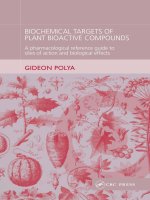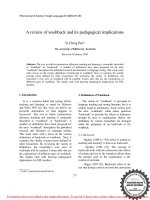PO review of phytochemistry and pharmacological effects
Bạn đang xem bản rút gọn của tài liệu. Xem và tải ngay bản đầy đủ của tài liệu tại đây (592.36 KB, 10 trang )
World Journal of Pharmaceutical Research
Godse.
Volume 9, Issue 3, 285-294.
SJIF Impact
Factor 8.084
World Journal of Pharmaceutical
Research
Review Article
ISSN 2277– 7105
PORTULACA OLERACEA L.: A REVIEW OF PHYTOCHEMISTRY
AND PHARMACOLOGICAL EFFECTS
*Shital D. Godse
Department of Pharmaceutical Chemistry, Smt. Kashibai Navale College of Pharmacy,
Kondhwa-Saswad Road, Kondhwa (Bk.), Pune. 411048, Maharashra State, India.
Article Received on
03 Jan. 2020,
ABSTRACT
Portulaca oleracea it is an aromatic, perennial, evergreen creeper of
Revised on 23 Jan. 2020,
Accepted on 13 Feb. 2020,
the mint family Lamiaceae. It is also called as ground-ivy, gill-over-
DOI: 10.20959/wjpr20203-16749
the-ground. Glechoma is also widely used in beer as flavoring,
clarification, and preservative. Sesquiterpenes; flavonoids, including
*Corresponding Author
quercetin, hyperoside, and apigenin; saponins; bitter principle,
Prof. Shital D. Godse
glechomine. it used as a diagestive, stimulant, expectorant,
Department of
abortificient, apetize, pectoral, diuretic, tonic, astringent, vermifuge.
Pharmaceutical Chemistry,
However, few molecular mechanisms of action are known. This review
Smt. Kashibai Navale
College of Pharmacy,
Kondhwa-Saswad Road,
gives a summary of phytochemistry and pharmacological effects of
Portulaca oleracea.
Kondhwa (Bk.), Pune.
411048, Maharashra State,
KEYWORDS:
Portulaca
oleracea
India.
pharmacology, Phytochemistry, antioxidant.
(Glechoma
hederacea),
INTRODUCTION
Portulaca oleracea of the mint family Lamiaceae. Which regularly known as Glechoma
hederacea (syn. Nepeta glechoma Benth., Nepeta hederacea (L.) Trevir.). it is found
throughout the Old World extending from North Africa through the Middle East and the
Indian Subcontinent to Malesia and Australasia. Vernacular name of the plant are ghol in
Marathi and hindi, in Sanskrit ghotaka, lonika, in Gujarati luni people language. The
synonyme of portulaca oleracia is ground-ivy, gill-over-the-ground, creeping charlie, alehoof,
tunhoof, catsfoot.
www.wjpr.net
Vol 9, Issue 3, 2020.
285
Godse.
World Journal of Pharmaceutical Research
It is an aromatic, perennial, evergreen creeper, field balm, and run-away-robin.[1] It is also
known as creeping jenny. It is widely used as medicinal plant and is used as a salad green in
many countries.
Glechoma hederacea L. (Labiatae) is used in folk medicine to treat different disease for
centuries.[1] portulaca oleracia has culinary and medicinal uses. Glechoma hederaceae L.,
two triterpene carboxylic acids, ursolic acid (UA) and oleanolic acid (OA) have been
isolated.[2] The fresh herb is also used to prepare an herbal tea which contain vitamin C in a
large amount, which is very useful for ageing factor and skin. It has a distinctive, mildly
peppery flavor; it can be cooked as a pot herb, in some of the country fresh leaves is eat as
green salad.
Glechoma was also widely used by the Saxons in brewing beer as flavoring, clarification, and
preservative, Sesquiterpenes; flavonoids, including quercetin, hyperoside, and apigenin;
saponins; bitter principle, alkaloids, hederacine A (1) and hederacine B (2), isolated from
Glechoma hederaceae.[3]
Glechoma hederacea contained only small amounts of squalene.[4] Since long time past
periods it used as a diagestive, stimulant, expectorant, abortificient, apetize, pectoral, diuretic,
tonic, astringent, vermifuge. However, few molecular mechanisms of action are known. In
this study, we provide detailed information on traditional uses, phytochemistry,
pharmacological uses, of portulaca oleracia.
Portulaca oleracea leaf
www.wjpr.net
Vol 9, Issue 3, 2020.
286
Godse.
World Journal of Pharmaceutical Research
TAXONOMY
Kingdom
Subkingdom
Superdivision
Division
Class
Subclass
Order
Plantae
Tracheobionta
Spermatophyta
Magnoliophyta
Magnoliopsida
Caryophyllidae
Caryophyllales
Family
Portulacaceae
Genus
Portulaca
Species
P. oleracea
Geographical Abstract
A) whole plant
B) Flower
c) Trichomes
d) Seed
É) Root
F) leaf
Different parts of Portulaca oleracia.
[(a) whole plant, (b) flower, (c) trichomes, (d) roots, (e) leaf]
www.wjpr.net
Vol 9, Issue 3, 2020.
287
Godse.
World Journal of Pharmaceutical Research
MEDICINAL USE portulaca oleracia is given to treat chronic catarrh, bronchitis, cystitis,
and tinnitus. It is also used to help reduce the symptoms of mild diarrhoea, piles, and gastritis.
The Chinese prescribe it for flu, kidney stones, trauma, rheumatoid arthritis, and skin sores.
Glechoma hederacea were selected as common European medicinal herbs and sources for tea
infusion preparations.[4] It is act as antioxidant, anti-inflammatory, antibacterial etc.[6-8]
3. Pharmacology
Over the past decades, many researchers have studied the pharmacological activities of
Glechoma hederacea this review gives information about a comprehensive summary of the
main pharmacological properties which are presented below. P. oleracea has been an
astringent, and a remedy for headaches, inflammation of the eyes and other organs, burning
of the stomach, erysipela, disorders of the bladder, numbness of the teeth, excessive sexual
desire, burning fevers, worms, dysentery, hemorrhoids, eruptions of blood, and bites.[5]
Phytochemistry
The Glechoma hederacea cells rich in caffeic, chlorogenic and rosmarinic acid.
Qualitative Phytochemical analysis
Alkaloid
Carbohydrate
glycoside
Tannin and phenolic compound
Flavonides
Fixed oil
saponin
Protein and amino acid
steroids
Table 1: Phytochemical screening of P.oleracea.
Sr. No
Test
1.
Alkaloid
2.
Carbohydrate
3.
glycoside
4.
Tannin and phenolic compound
5.
Flavonides
6.
Fixed oil
7.
saponin
8.
Protein and amino acid
9.
steroids
www.wjpr.net
Vol 9, Issue 3, 2020.
Methanol extract
+
+
+
+
+
+
+
288
Godse.
World Journal of Pharmaceutical Research
Chemical constituents
hydroxycinnamoyl-CoA:shikimate
hydroxycinnamoyltransferase
(HST),
an
important
enzyme of monolignol formation, in leaves, flowers, stems and roots of naturally grown G.
hederacea were proved. The expression of RAS and HST genes was found in all organs only
not in roots. Flowers contain 12.5% RA in their dry mass, leaves, stems and roots about 1%.
Chlorogenic Acid was found in leaves (2.0%), while it was at 1.6% in flowers, 1.3% in stems
and almost undetectable in roots, means chlorogenic acid found highest in leaf. The caffeic
acid content remained at or below 0.4% of the dry weight in all organs.
Antitumor
To know the effect of P. Oleracea two triterpene carboxylic acids, oleanolic acid (OA) and
ursolic acid (UA) has been isolated as inhibitors of 12-O-tetradecanoylphorbol-13-acetate
(TPA) induced Epstein-Barr virus (EBV) activation in Raji cells. Both acids strongly
inhibited the activation at a 1000-fold molar ratio to 12-O-tetradecanoylphorbol-13-acetate
TPA, and also teleocidin B-4. The effect of P. oleracaea as an antitumor was very similar to
the antitumor promoters, retinoic acid (RA) and glycyrrhetinic acid (GA).[1] Ursolic acid
(UA) and oleanolic acid (OA), which has been isolated from Glechoma hederacea as
inhibitors of Epstein-Barr virus (EBV) activation induced by 12-O-tetradecanoylphorbol-13acetate (TPA), were tested against inhibitory effect on tumor promotion by TPA in vivo.
They inhibited strongly the tumor promotion in mouse skin and the activities were
comparable to that of a known inhibitor of tumor promotion, retinoic acid (RA) which having
www.wjpr.net
Vol 9, Issue 3, 2020.
289
Godse.
World Journal of Pharmaceutical Research
the antitumor property.[6] Three new sesquiterpene lactones namely, 1 α,10 β-epoxy-4hydroxy-glechoma-5-en-olide (1), 1 β,10 α-epoxy-4,8-dihydroxy-glechoma-5-en-olide (2),
and 1 β,10 α;4 α,5 β-diepoxy-8-methoxy-glechoman-8 α,12-olide (3), has been isolated from
the whole plant of Glechoma hederacea, together with four known sesquiterpene lactones.
The structures of the three new sesquiterpene lactones were determined by spectroscopic
evidence. Cytotoxic effects of the isolated compounds were examined against MDA-MB-231
(breast), HCT116 (colon), SW620 (colon), and DU145 (prostate) human cancer cell lines.
And in this study it was conclude that Glechoma hederacea contain antitumor property.[17]
kim lee.
Antioxident
Glechoma hederacea, once popular as a medicinal plant and as a bitter beer supplement
because it is a rich in phenolic antioxidants such as rosmarinic acid and flavonoids.
Antioxidant property of Glechoma hederacea can use in traditionally in phytotherapy and to
their preventive value in diseases. the effects of Glechoma hederacea Antioxidant property
has been determined by Species to test their antioxidant capacity by using three types of
assays. Primary screening for total polyphenols and phenolic acids was also performed to find
correlations with the activity. Fractionation of the Glechoma hederacea crude extracts were
carried out to know the contributions of compounds of different polarity to total antioxidant
property. In the stated study the extracts were fractionated using liquid-liquid extraction by
using with petroleum ether (PE), dichloromethane (DCM), ethyl acetate (EA), and n-butanol
(BuOH). All extracts and fractions were studied for their antioxidant activity using UVSpectrophotometric assays: DPPH scavenging, phosphomolybdenum reduction, and
deoxyribose degradation assay.[7] In the present study they extracts Glechoma hederacea
plants in water by infusion, maceration, and decoction for characterization of their
polyphenol content and antioxidant capacity. Based on the extraction efficiency of
polyphenols, the final extract was obtained whose polyphenolic profile, polysaccharides,
mineral content, and cytoprotective activities were determined. The content of polyphenols
and antioxidant capacity was determined in Glechoma hederacea.[8] In the present study they
made Ethanol-water (8:2, v/v) and purified ethyl acetate extracts of the plan results showed
that it possess significant antioxidant activity. Tests were performed on, prime steam pork
lard and active-carbon-treated edible sunflower oil, using Schaal oven test storage conditions
at 60 degrees C. The ethanol-water and purified ethyl acetate extracts of Glechoma hederacea
showed strong antioxidant activity.[9] milo anti.
www.wjpr.net
Vol 9, Issue 3, 2020.
290
Godse.
World Journal of Pharmaceutical Research
Antinflammetry
In the released study indicate that the effects of Glechoma hederacea, has been widely used
in folk remedies for get ride symptoms of inflammation.[10] Glechoma hederacea is an herbal
plant used in medicine to treat inflammation. Its anti-inflammatory effect, by inhibition of
NO synthesis and the pro-inflammatory cytokine TNF-α, have been demonstrated.[11] In this
study, the effect of Glechoma hederacea on interferon-gamma (IFN-gamma) and
lipopolysaccharide (LPS)-induced production of nitric oxide (NO), interleukin (IL)-12p70,
IL-12p40, tumor necrosis factor-alpha (TNF-alpha), and IL-6 were examined using mouse
peritoneal macrophages. Glechoma hederacea inhibits IFN-gamma/LPS-induced NO in a
dose-dependent manner.[18] milo anti.
Anti-melanogenesis
In the released study indicate that the effect of G. hederacea extract regarding to
melanogenesis in B16 melanoma cells effects was examined. The result states the It
significantly reduced both the cellular melanin content and tyrosinase activity in a
concentration-dependent manner. G. hederacea extract inhibits melanin synthesis in B16
melanoma cells but is not cytotoxic. Hence it prove a useful therapeutic agent for treating
pigmentation and an effective component of skin whitening cream.[1] The Antimelanogenesis effect of G. hederacea demonstrate that it inhibiting the secretion of proinflammatory cytokines and melanogenic paracrine factors from keratinocytes, than to direct
inhibition of melanogenic activities in melanocytes.[10]
Insecticidal
In the released study indicate that the leaves of ground ivy (Glechoma hederacea) contain a
lectin it is also called as Gleheda, Insect feeding trials proveded that Gleheda is a potent
insecticidal protein for larvae of the Colorado potato beetle (Leptinotarsa decemlineata). [11],
the present study states that the potent insecticidal lectin, Gleheda, from the leaves of
Glechoma hederacea (ground ivy).[12]
Bactericidal
The antibacterial potential of Portulaca oleracea. was assessed release studies indicated that
the Glechoma hederacea L. is most toxic; with the EC50 of 0.4073 g dried plant/l. LC50
values identified by the standard bioassay proved that it is a good indicator of the bactericide
property of plant. In the released study indicate that the a microbial ecotoxtest was evaluated
to quantify the aggregate bactericide capacity of Labiatae species, based on the
www.wjpr.net
Vol 9, Issue 3, 2020.
291
Godse.
World Journal of Pharmaceutical Research
bioluminescence inhibition of the bacterium Vibrio fischeri. Striking differences were found
amongst herbs, reaching even 10-fold toxicity.[13]
CONCLUSION
The objective of this review is to study the recent advances in the exploration of the plant
Portulaca oleracea. The information helpful to search the use of p. Oleracea in various
disease. The plant is reported to contain mainly caffeic, chlorogenic and rosmarinic acid
which might be useful in the development of new drugs entity of versatile nature to treat
various diseases because of their potent antioxidant and antinflammatory property. Hence;
there is scope for research work leading to commercial utilization of the Plant oleracea in
future.
REFERENCES
1. Qiao Z, Koizumi Y, Zhang M, Natsui M, Flores MJ, Gao L, Yusa K, Koyota S, Sugiyama
T, Anti-melanogenesis effect of Glechoma hederacea L. extract on B16 murine melanoma
cells, Biosci Biotechnol Biochem, 2012; 76(10): 1877-83.
2. H. Ohigashi, H. Takamura, K. Koshimizu, H. Tokuda, and Y. Ito, “Search for possible
antitumor promoters by inhibition of 12-O-tetradecanoylphorbol-13-acetate-induced
Epstein-Barr virus activation; Ursolic acid and oleanolic acid from an anti-inflammatory
Chinese medicinal plant, Glechoma hederaceae L, Cancer Letters, 1986; 30(2): 143–151.
3. Kumarasamy Y, Cox PJ, Jaspars M, Nahar L, Sarker SD. Isolation, structure elucidation
and biological activity of hederacine A and B, two unique alkaloids from Glechoma
hederaceae Tetrahedron, 2003; 59: 6403-7.
4. Eva Dadáková, Naděžda Vrchotová, Jan Tříska, Content of selected biologically active
compounds in tea infusions of widely used European medicinal plants, Journal of
agrobiology, 2010; 27(1): 27–34.
5. Milad Iranshahya Behjat Javadib Mehrdad Iranshahia Seyedeh Pardis Jahanbakhsh, A
review of traditional uses, phytochemistry and pharmacology of Portulaca oleracea L,
Journal of Ethnopharmacology, 9 June 2017; 205: 158-172.
6. Tokuda H, Ohigashi H, Koshimizu K, Ito Y, Inhibitory effects of ursolic and oleanolic
acid on skin tumor promotion by 12-O-tetradecanoylphorbol-13-acetate. Cancer Lett.,
1986 Dec; 33(3): 279-85.
www.wjpr.net
Vol 9, Issue 3, 2020.
292
Godse.
World Journal of Pharmaceutical Research
7. Adam Matkowski, Antioxidant Activity of Extracts and Different Solvent Fractions of
Glechoma hederacea L. and Orthosiphon stamineus (Benth.) Kudo, Advances in Clinical
and Experimental Medicine, November 2008; 17(6): 615-624,
8. Belščak-Cvitanović A1, Durgo K, Bušić A, Franekić J, Komes D. Phytochemical
attributes of four conventionally extracted medicinal plants and cytotoxic evaluation of
their extracts on human laryngeal carcinoma (HEp2) cells. J Med Food, 2014 Feb; 17(2):
206-17.
9. Antioxidant effects of Glechoma hederacea as a food additive. Milovanovic M1, Zivkovic
D, Vucelic-Radovic B, Natural Product Communications, 2010 Jan; 5(1): 61-3.
10. Hwang JK, Erkhembaatar M, Gu DR, Lee SH, Lee CH, Shin DM, Lee YR, Kim MS. J
Dent Res. Glechoma hederacea Suppresses RANKL-mediated Osteoclastogenesis, 2014
Jul; 93(7): 685-90.
11. Ha JH, Kang WH, Lee JO, Cho YK, Park SK, Lee SK, Cho HK. Clinical evaluation of
the depigmenting effect of Glechoma Hederacea extract by topical treatment for 8 weeks
on UV-induced pigmentation in Asian skin. Eur J Dermatol, 2011 Mar-Apr; 21(2):
218-22.
12. Wang W, Hause B, Peumans WJ, Smagghe G, Mackie A, Fraser R, van Damme EJ. The
Tn antigen-specific lectin from ground ivy is an insecticidal protein with an unusual
physiology. Plant Physiol, 2003 Jul; 132(3): 1322-34.
13. Singh T, Wu JH, Peumans WJ, Rougé P, Van Damme EJ, Alvarez RA, Blixt O, Wu AM
Carbohydrate specificity of an insecticidal lectin isolated from the leaves of Glechoma
hederacea (ground ivy) towards mammalian glycoconjugates. Biochem J., 2006 Jan 1;
393(Pt 1): 331-41.
14. Kováts N, Ács A, Gölöncsér F, Barabás A. Quantifying of bactericide properties of
medicinal plants. Plant Signal Behav, 2011 Jun; 6(6): 777-9.
15. Kim J, Song S, Lee I, Kim Y, Yoo I, Ryoo I, Bae K, Anti-inflammatory activity of
constituents from Glechoma hederacea var. longituba. Bioorganic Medicinal Chemistry
journal, Lett., 2011 Jun 1; 21(11): 3483-7.
16. Wang YY, Lin SY, Chen WY, Liao SL, Wu CC, Pan PH, Chou ST, Chen CJ. Glechoma
hederacea extracts attenuate cholestatic liver injury in a bile duct-ligated rat model
Research article Journal of Ethnopharmacology, 23 May 2017; 204: 58-68.
17. Kim J, Lee I, Ha D, Seo J, Min B, Yoo I, Bae K. New sesquiterpene lactones from
Glechoma hederacea L. and their cytotoxic effects on human cancer cell lines. Planta
Med., 2011 Jun; 77(9): 955-7.
www.wjpr.net
Vol 9, Issue 3, 2020.
293
Godse.
World Journal of Pharmaceutical Research
18. Kim J1, Lee I, Ha D, Seo J, Min B, Yoo I, Bae K, New sesquiterpene lactones from
Glechoma hederacea L. and their cytotoxic effects on human cancer cell lines. Journal of
Ethnopharmacology, 10 Mar 2006; 106(3): 418-424.
www.wjpr.net
Vol 9, Issue 3, 2020.
294









